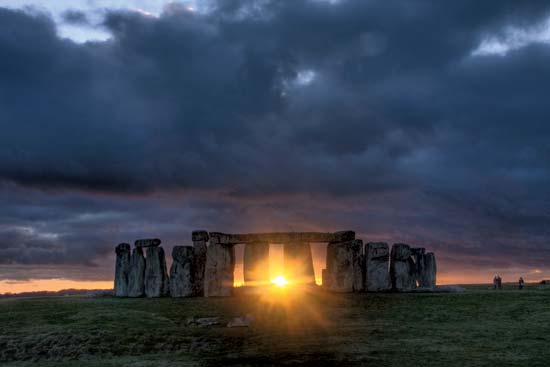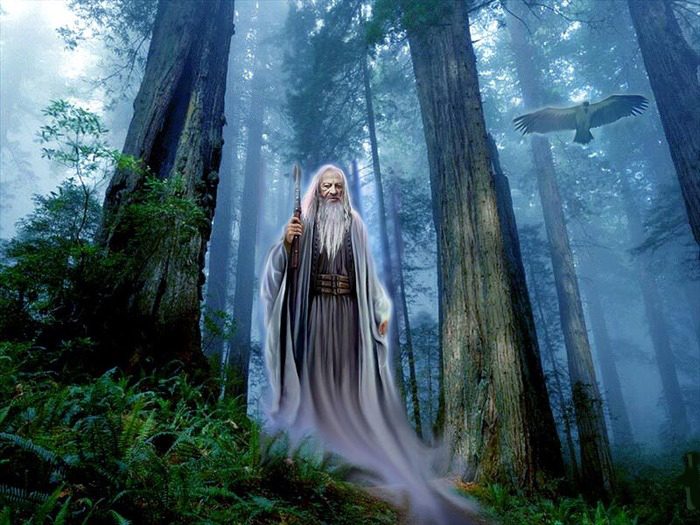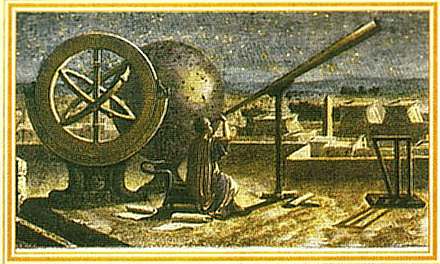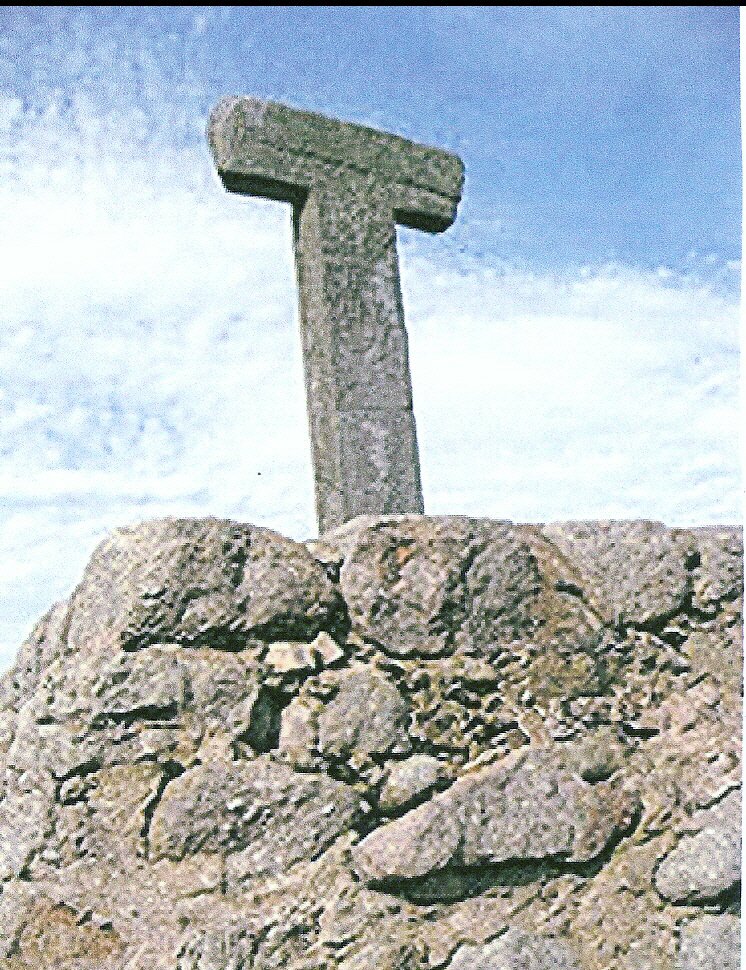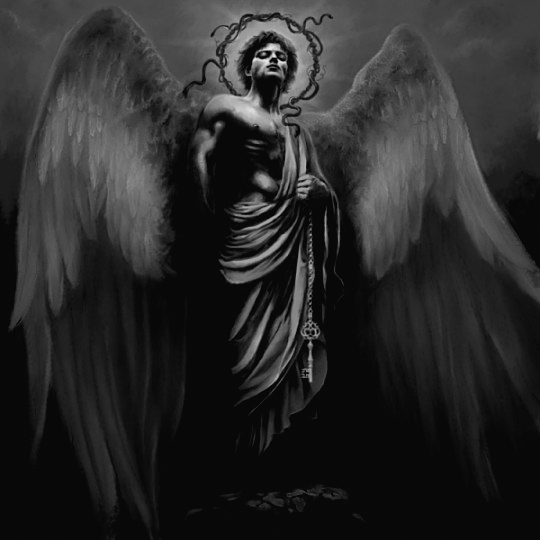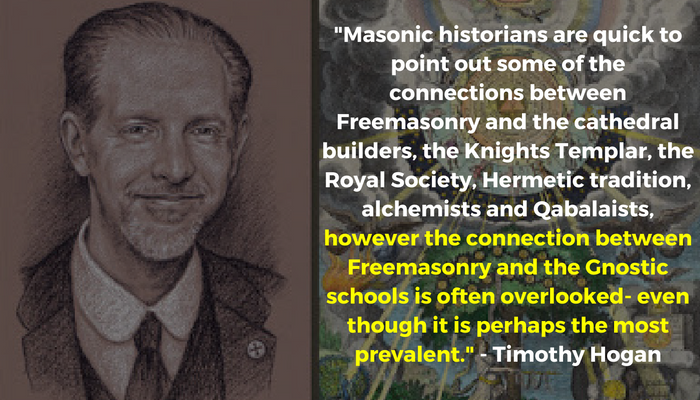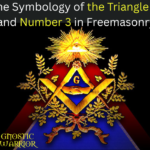“Love one another, teach one another, help one another. That is all our doctrine, all our science, all our law.”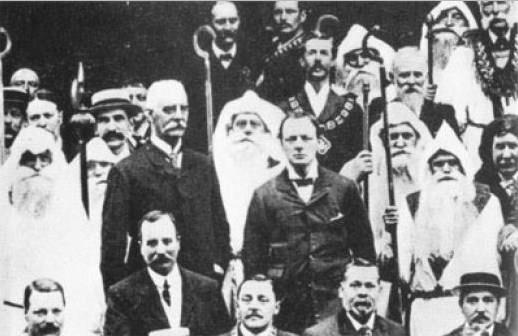
Ah! rail against us bigoted and ignorant men, slander us curious and jealous women if you will. Those who obey the precepts of their masters, and those who listen to the truths which they inculcate can readily forgive you. It is impossible to be a good Mason without being a good man.
We have no narrow-minded prejudices; we do not debar from our society this sect or that sect; it is sufficient for us that a man worships God, no matter under what name or in what manner, and we admit him. Christians, Jews, Mahometans, Buddhists are enrolled among us, and it is in the Mason’s Lodge alone that they can kneel down together without feeling hatred, without professing contempt against their brother worshippers.
(The image above is of Freemason, and Prime Minister: Winston Churchill (center) in a gathering of The Ancient Order of Druids.)
Freemasonry and the Druids By W. Winwood Reade
The brethren seated in a circle, one of the Masters arises and advances to the midst. He relates to them a tradition of the origin of their craft.
“After the sun had descended down the seventh age from Adam before the flood of Noah, there was born unto Methusael, the son of Mehujael, a man called Lamach who took unto himself two wives. the name of the one was Adah, of the other Zillah. Now Adah his first wife, bare two sons–the one named Jabel and the other Jubal. Jabal was the inventor of geometry and the first who built houses of stone and timber, and Jubal was the inventor of music and harmony. Zillah, his second wife, bare Tubal Cain, the instructor of every artificer in brass and iron, and a daughter called Naamah who was the founder of the weaver’s craft.
“All these had knowledge from above, that the Almighty would take vengeance for sin either by fire
or by water, so great was the wickedness of the world. So they reasoned among themselves how they might preserve the knowledge of the sciences which they had found, and Jabal said that there were two different kinds of stone of such virtue that one would not burn and the other would not sink– the one called marble and the other latres. They then agreed to write all the science that they had found upon these stones.
“After the destruction of the world, these two pillars were discovered by Hermes, the son of Shem. Then the craft of masonry began to flourish, and Nimrod was one of the earliest patrons of the art. Abraham, the son of Jerah, was skilled in the seven sciences and taught the Egyptians the science of grammar. Euclid was his pupil, and instructed them in the art of making mighty walls and ditches to preserve their houses from the inundations of the Nile, and by geometry measured out the land, and divided it into partitions so that each man might ascertain his own property. And he it was who gave masonry the name of geometry.
“In his days, it came to pass that the sovereign and lords of the realm had gotten many sons unlawfully by other men’s wives, insomuch that the land was grievously burdened with them. A council was called but no reasonable remedy was proposed. The king then ordered a proclamation to be made throughout his realms, that high rewards would be given to any man who would devise a proper method for maintaining the children. Euclid dispelled the difficulty. He thus addressed the king: ‘My noble sovereign, if I may have order and government of these lord’s sons, I will teach them the seven liberal sciences, whereby they may live honestly like gentlemen, provided that you will grant me power over them by virtue of your royal commission.’
“This request was immediately complied with, and Euclid established a Lodge of Masons.”
This tale is curious as being the earliest account of an educational institution. There are various traditions of minor interest relating to the patriarchal ages and to the wanderings of the Israelites in the wilderness.
The Freemasons claim descent from that body of builders who, some from Phœnicia, and some from India, came to Jerusalem to erect the temple of Solomon. They also assert that these masons were governed by the same laws, and united by the same ties as those of the modern order, and in the initiation of a Master-mason the following tradition is related respecting the death of the Phœnician Hiram Abiff, the master architect who directed the building of the temple:
“There were fifteen fellow-craftsmen, who finding that the temple was almost finished, and that they had not received the master’s word because their time was not come, agreed to extort it from their master, the skilful Hiram Abiff, on the first opportunity, that they might pass for masters in other countries and have masters’ wages. Twelve recanted and the other three determined to carry out the plot. Their names were Jubela, Jubelo, and Jubelum. These three crafts knowing that it was always the master’s custom at twelve at noon, when the men were called off to refreshment, to go into the sanctum sanctorum to pray to the true and living God–they placed themselves at the three entrances to the temple, viz., at the west, south and east doors. There was no entrance in the north, because thence the sun darts no rays. Thus they waited while he made his prayer to the Lord, to have the word or grip as he came out, or his life.
So Hiram came to the east door, and Jubela demanded the master’s word. Hiram told him he did not receive it in such a manner but he must wait, and time and a little patience would bring him to it, for it was not in his power to deliver it except the three Grand Masters were together, viz: Solomon, King of Israel, Hiram, King of Tyre, and Hiram Abiff.
“Jubela struck him across the throat with a 24-inch gauge. He fled thence to the south door where he was accosted in the same manner by Jubelo to whom he gave a similar answer, and who gave him a blow with a square upon his left breast. Hiram reeled but recovered himself, and flew to the west door where Jubelum gave him a heavy blow upon the head with a common gavel or setting maul which proved his death.
“After this they carried him out of the west door and hid him in a heap of rubbish till it was twelve at night, when they found means to bury him in a handsome grave, six feet east and west, and six feet in height.
“When Hiram was missed, King Solomon made great inquiry after him, and not hearing anything of him supposed him to be dead. The twelve crafts that had recanted hearing the said report, and their consciences pricking them, went and informed King Solomon with white aprons and gloves as tokens of their innocence. King Solomon forthwith sent them in search of the three murderers who had absconded, and they agreed to make the pursuit in four parties, three going north, three south, three east, and three west.
“As one of these parties traveled down to the sea of Joppa, one of them sitting himself down to rest by the side of a rock, heard the following lamentations proceed from a cleft within:–
“‘O that I had my throat cut across, and my tongue torn out by the root, and buried in the sands of the sea at low water a cable length from the shore, where the tide doth regularly ebb and flow twice in the course of the twenty-four hours, than that I had been concerned in the death of our master Hiram.’
And then another voice:
“‘Oh! that I had my heart torn from under my naked left breast, and given to the vultures of the air as a prey, rather than I had been concerned in the death of so good a master.’
“‘But oh!’ cried Jubelum. I struck him harder than you both, for I killed him. Oh! that I had had my body severed in two, one part carried to the south, and the other to the north, my bowels burnt to ashes and scattered before the four winds of the earth, rather than I had been concerned in the death of our master Hiram.’
“The brother that heard these sorrowful lamentations hailed the other two, and they went into the cleft of the rock and took them and bound them, and brought them before King Solomon, when they owned what had passed, and what they had done, and did not desire to live, therefore King Solomon ordered their own sentences to be executed upon them, saying, ‘They have signed their own deaths, and let it be upon them as they have said.’
“‘Jubela was taken out, and his throat cut across, and his tongue torn out by the root, and buried in the sands of the sea at low water, a cable length from the shore, where the tide did regularly ebb and flow twice in the course of the twenty-four hours.
“Jubelo’s heart was torn from under his naked left breast, and was given to the vultures of the air as a prey.
“Jubelum’s body was severed in two, one part was carried to the north, the other to the south, his bowels were burnt to ashes and scattered to the four winds of the earth.”
The real secret of Freemasonry, viz., its origin and purport, as yet remain an enigma and will probably ever remain so.
There are some authors who have fixed the source of this sacred and mysterious fountain within the oaken groves of the extinguished order of the Druids.
Who assert that when Druidism was proscribed, its priests adopted various disguises and carried their learning into various professions. Some became school-masters and taught science to the youth of Britain, as they had once done in the forest seminaries of Mona. Some fortune-tellers, the parents of the tribes of gypsies who still retain a kind of brotherhood united by oaths and secret signs, and who at one time possessed so strange an ascendancy over the minds of the vulgar.
And others who formed themselves into a community resembling, if not in their power, at least in their unanimity, that ancient body of priests who had once been the sovereigns of Britain.
At first I was inclined to believe that such was really the case, and that Freemasonry was no more than a reproduction of Druidism in the Middle Ages. On searching for materials, I met with evidence in limine which tended to confirm me in this conviction. There was a manuscript discovered in the Bodleian Library at Oxford in 1696, which was supposed to have been written about the year 1436. It purports to be an examination of one of the brotherhood by King Henry VI, and is allowed by all masonic writers to be genuine.
Its title is as follows: “Certain questions with answers to the same concerning the mystery of masonry written by King, Henry the Sixth and faithfully copied by me John Leylande, antiquarian, by command of his highness.”
I give an extract modernizing the English of the original, which, though quaint, would be unintelligible to all but antiquaries:–
“What mote it be? It is the knowledge of nature, and the power of its various operations; particularly the skill of reckoning, of weights and measures, of constructing buildings and dwellings of all kinds, and the true manner of forming all things for the use of man.
“Where did it begin ?-it began with the first men of the East, who were before the first men of the West, and coming with it, it hath brought all comforts to the wild and comfortless.
“Who brought it to the West?–the Phoenicians who, being great merchants, came first from the East into Phoenicia, for the convenience of commerce, both East and West by the Red and Mediterranean Seas.
“How came it into England?–Pythagoras, a Grecian, traveled to acquire knowledge in Egypt and in Syria, and in every other land where the Phoenicians had planted masonry; and gaining admittance into all lodges of masons, he learned much, and returned and dwelt in Grecia Magna, growing and becoming mighty wise and greatly renowned. Here he formed a great lodge at Crotona, and made many masons, some of whom traveled into France, and there made many more, from whence, in process of time, the art passed into England.”
This, I need not remind the reader, is a story very similar to those current respecting the first planting of Druidism in Britain.
I also discovered as I thought, a key to the tradition of Hiram Abiff, which I have just related, viz., that it was simply the story of Osiris (killed by Typhon the Evil Spirit, buried in a coffin and found by Isis) so corrupted by modern Masons.
In the continuation of the story of Hiram, it is stated that the twelve crafts on discovering his body were unable to raise it, and that King Solomon ordered a lodge of master-masons to be summoned and said, “I will go myself in person and try to raise the body by the master’s grip or the lion’s paw.
By means of this grip the Grand-Master Hiram was raised.
Now in a figure painted on a mummy at the Austin Fryar’s of La Place des Victores, representing the death and resurrection of Osiris, is seen an exact model of the position of the master-mason as he raises Hiram.
Jubela, Jubelo, Jubelum are merely variations from the Latin word jubeo, I command. The pretended assassins are represented as demanding the master’s grip and word from Hiram in an imperious manner. A more satisfactory proof of the truth of this statement is contained in an astronomical notion of the Hindus, whose Chrisna is the same as the Osiris of the Egyptians.
The Decans, or Elohim, are the gods of whom it is said the Almighty created the Universe. They arranged the order of the zodiac. The Elohim of the summer were gods of a benevolent disposition: they made the days long, and loaded the sun’s head with topaz. While the three wretches that presided in the winter at the extreme end of the year, hid in the realms below, were, with the constellation to which they belonged, cut off from the rest of the zodiac;
and as they were missing, were consequently accused of bringing Chrisna into those troubles which at last ended in his death.
Even allowing these premises to be true, it does not necessarily follow that the traditionary account of the building of Solomon’s Temple by masons was also allegorical.
And indeed there is so much that is purely Hebrew in ceremonial masonry, that one is almost forced to believe that the Freemasons of the present day are really descended from a body of architects, who, like the Dionysiacks of Asia Minor, were united into a fraternal association and who erected the temple of Solomon.
In these ceremonies, however, and in their emblems there is much also that is Druidic, and if Freemasonry did not emanate from Druidism, there can be no doubt that it sprang from the same origin.
I will trace out the affinity between the Masonic Order of the Present, and the Druid Order of the Past. It shall be for the reader to decide whether these Masonic usages are vestiges of Druidism, or mere points of family resemblance.
The initiations of Masons are so similar to those of the Druids, that any Mason reading my article upon the subject must have been struck by the resemblance.
The ovade wore a gold chain round his neck. And the apprentice when initiated has a silk cord, in masonic parlance a cable-tow, suspended from his throat. Like the ovade, the apprentice is blindfolded, and as the former was led through the mazes of a labyrinth, the latter is led backwards and forwards, and in various directions.
Thunder and lightning were counterfeited in the initiation of a Druid, and in that of the Royal Arch the Companions fire pistols, clash swords, overturn chairs, and roll cannon balls across the floor.
The tiler stands at the door with a drawn sword.
And tests of fortitude though less severe than in former times are not unknown among Masons. The following arduous trial was used in the Female Lodges of Paris:–
“A candidate for admission was usually very much excited. During a part of the ceremony she was conducted to an eminence, and told to look down at what awaited her if she faltered in her duty. Beneath her appeared a frightful abyss in which a double row of iron spikes were visible. No doubt her mind was in a chaos of fanaticism, for instead of shrinking at the sight, she exclaimed “I can encounter all,” and sprang forward. At that moment a secret spring was touched, and the candidate fell not on the spikes, but on a green bed in imitation of a verdant plain. She fainted but was soon recovered by her friends, when the scene having changed she was reanimated and soothed by the sweet strains of choral music.”
I have already shown, I trust conclusively, that the Druidic mysteries were founded on those of the Egyptians, and were analogous to those of Tyre, Persia and Hindostan; and that their moral doctrines and pristine simplicity of worship were those of the Hebrew Patriarchs.
It will be easy to show that those of Freemasonry, if not a mere perpetuation of the Druidic were derived from the same fountains, and that the secrets of this science and philosophy are hidden from us by the veil of Isis.
To the Egyptian candidate on his- initiation, the Hierophant displayed the holy volume of hieroglyphics which he then restored to its repository.
So when the eyes of the apprentice are first released from darkness, he beholds the volume of the sacred law.
During the Persian initiations, the doctrine was enforced ex cathedra, from the desk or pulpit. So the Grand Master sits on a throne before which the candidate kneels, pointing a dagger to his naked left breast and two white wands being crossed above his head.
On the seal of the ancient Abbey of Arbroath in Scotland, is a representation which bears a curious resemblance to the engraving on a seal used by the priests of Isis, and which Plutarch describes in his Essay on Isis and Osiris–a man kneeling, his hands bound, and a knife at his throat.
In all the ancient mysteries before an aspirant could claim participation in the higher secrets of the institution, he was placed within the pastos or bed, or coffin, and was subjected to a confinement in darkness for a certain time.
This I have described to be practiced by the Druids. In some of their labyrinths, discovered in France, the remains of cells have been found, and there was a dark cell of probation recently standing near Maidstone, Kitt’s Cotti House–from Ked (or Ceridwen) the British Isis, and cotti an ark, or chest.
So in the initiation of a Master Mason, the candidate is in some lodges buried in a coffin to represent the death of the murdered Hiram Abiff.
The grand festival of Masonry is on Midsummer Day, which was also the grand festival of the Druids.
The processional movements of the Masons as of the Druids were mostly circular.
I have already instanced the symbol by which the Jews expressed the word ‘Jehovah.’ This letter jod was believed by them to denote the presence of God, especially when conveyed in a circle.
Masons also have a word which they are not allowed to pronounce except in the presence of a full lodge, and they pay peculiar reverence to a point within a circle. Some of the Druidic monuments are simple circles with a stone standing in the midst, and the boss in the centre of their circular shields had probably the same signification.
The Masonic Lodge, like all Pagan temples, is built due east and west. Its form is an oblong square which the ancients believed to be the shape of the world. In the west are two pillars surmounted by globes. The one on the left is called Boaz, and is supposed to represent Osiris or the sun, the other Jachin, the emblem of Isis or the moon. The floor is mosaic, and the walls are adorned with the various symbols of the craft.
The cross is one of the chief emblems in Masonry as it was in Druidism, and in all the Pagan religions. The Taw is a badge in Royal Arch Masonry, and almost all the other varieties of the symbol are used in Masonry.
The key and the cross-keys are also mosaic symbols. They are supposed to be astronomical signs of Anubis, or the Dog-Star.
An ear-of-corn is a prominent emblem in Masonry, proving that the order did not confine their intellects and their labors to the building of houses, but devoted themselves also to agriculture.
A sprig of acacia is one of the emblems revered by the Masons, and answers to the Egyptian lotus, to the myrtle of Eleusis, to the golden branch of Virgil and to the Druidic mistletoe. It is curious that Houzza which Mahomet esteemed an idol–Houzza so honored in the Arabian works of Ghatfân Koreisch, Kenanah and Salem should be simply the acacia. Thence was derived the word huzza! in our language, which was probably at first a religious exclamation like the Evohe! of the Bacchantes.
The doctrines of Masonry are the most beautiful that it is possible to conceive. They breathe the simplicity of the earliest ages animated by the love of a martyred God. That word which the Puritans translated “charity,” but which is really “love”–love is the key-stone of the Royal Arch upon which is supported the entire system of this mystic science.
In the lectures of the French Lodges the whole duty of a Mason is summed up in this one brief sentence: “Aimez-vous les uns les autres, instruisez-vous, secourez-vous, voilà tout noire livre, toute noire loi, toule noire science.”
“Love one another, teach one another, help one another. That is all our doctrine, all our science, all our law.”
Ah! rail against us bigoted and ignorant men, slander us curious and jealous women if you will. Those who obey the precepts of their masters, and those who listen to the truths which they inculcate can readily forgive you. It is impossible to be a good Mason without being a good man.
We have no narrow-minded prejudices; we do not debar from our society this sect or that sect; it is sufficient for us that a man worships God, no matter under what name or in what manner, and we admit him. Christians, Jews, Mahometans, Buddhists are enrolled among us, and it is in the Mason’s Lodge alone that they can kneel down together without
feeling hatred, without professing contempt against their brother worshippers.

Moe is the founder of GnosticWarrior.com. He is a father, husband, author, martial arts black belt, and an expert in Gnosticism, the occult, and esotericism.


